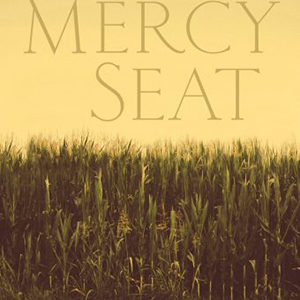Already, by 1960, Garry Winogrand was taking pictures that didn’t make any sense. Even now, we struggle to get a handle on them, but back then, before the pictures had altered the grammar of photography sufficiently to enable us to get to grips with them . . .
The amount of information in the photograph below is considerable but the ordering of it so minimal—or discreet, at any rate—it’s difficult to know how to process it. How many lives are being actively lived in this picture? What is happening? What are we looking at? For one thing, we’re looking at a manifestation or projection of our own confusion in the form of the guy scratching his head, a gesture that might for him be purely mechanical (an itch?) but which here becomes imbued with psychological and existential weight because he is asking the question we are asking: What is going on here? So the person asking this question becomes the key to the riddle of which he is a central part.
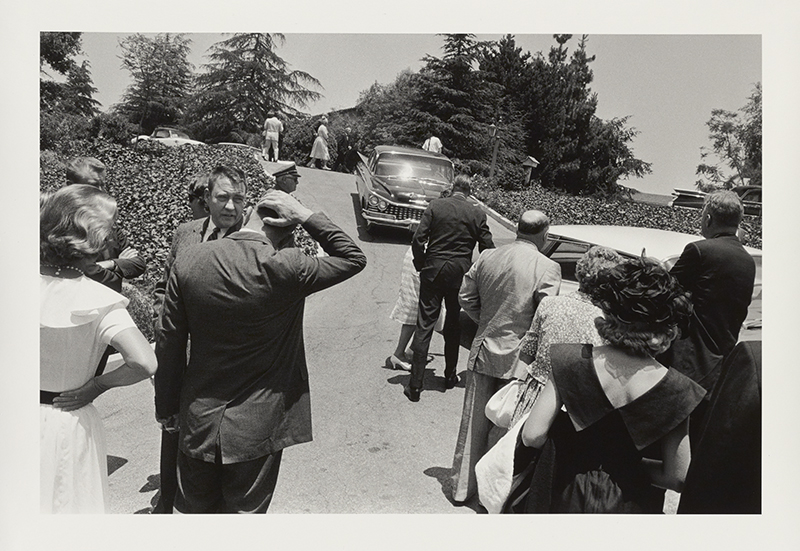
This key turns out to be compositional even though, back in 1960, it seemed to many that Winogrand had given composition the elbow—in this instance, quite literally. The elbow is the element on which the whole picture hinges. The head-scratcher’s elbow links arms, as it were, with those of the other walkers—especially the woman in the white dress, behind him and to his left—which leads, in turn, to those of the woman in the black dress, the diagonal straps of which mirror the triangulation of upper and lower arm hinged at the elbow. I don’t want to make too much of this but once you start looking it seems that the cars have somehow sprouted elbows in the form of fins, as have the trees, in the form of branches. And look at the triangular peaked cap of the parking attendant (if that’s what he is) right above the head-rubbing hand.
But something else is important, too. The abundance of information is matched always by the amount withheld. In spite—and because—of everything that’s going on, it’s impossible to tell what’s going on.
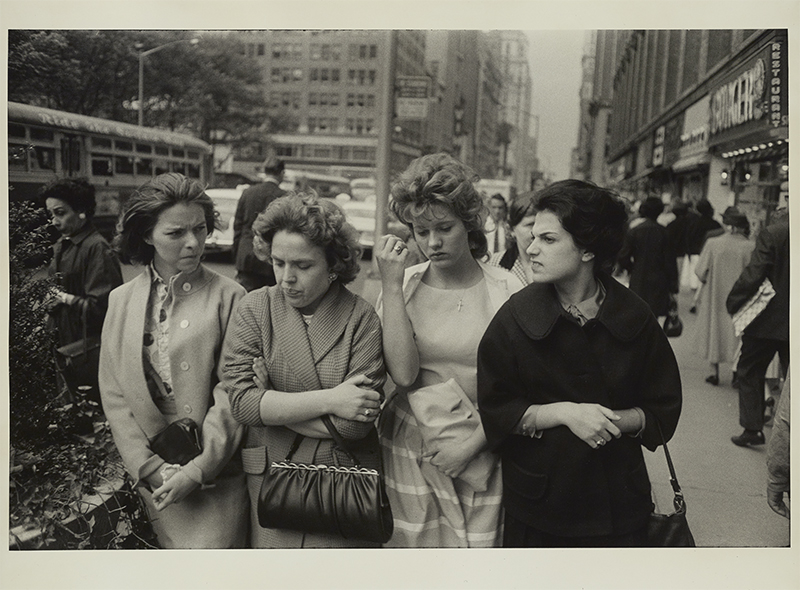 1960, New York.
1960, New York.
There are so many continuities in Winogrand’s photography. As befits a photographer whose work resembles that of a realist novelist—Balzac or Elena Ferrante—we observe a cast of characters as they change over time. Now, this being street photography—pictures taken over a long period, of people chosen at random, often in the busy, overpopulated streets of Manhattan—we can’t expect Winogrand to photograph exactly the same people. So perhaps we need to change the comparison from literature to feature films in which the same characters, as they age, are played by different actors.
This picture features the “same” women we will see again in another photograph. They will lead their lives. Things will happen. They will have their ups and downs. There will be quarrels. All the usual things will happen or not happen. But we will bump into them again when they are 30 years older (even if, in actual time, only a few years have passed).
The gain in this is that Winogrand could show people aging without having to wait. He could show people aging in a way that is independent of history. In other words he could even show people aging at pretty much the same moment in time.
As it happens, a year after taking this photograph, he also photographed these “same” women when they were teenage girls! The corollary of this is that he can show the same people, at the same biological age, at a different point in history (15 or 20 years later or earlier).
The difference—without wanting to give too much away about the later picture—is that here the focus is on hands. The hands are enough to show this as a pre-feminist moment. Maybe it’s as simple as that; here they are clutching their femininity or—and it amounts to the same thing—clutching themselves: clutching their limitations, holding themselves together within the roles and possibilities they have been assigned. No wonder they look unhappy. Fifteen years from now women of comparable age will be freeing their hands.
 1964, Portland, Oregon.
1964, Portland, Oregon.
Life is about decision and indecision. There are a few big decisions to make: whether to marry a certain person, whether to move to a new city or country, whether to have a child. But each day is packed with thousands of mini or micro decisions: where to have coffee, whether to accelerate before a green traffic signal turns red, whether to have an alcoholic drink. All the people in the background of this picture have made up their minds. They know where they’re going. In the middle, though, is this little family group stranded utterly in the midst of decision-making. Which way are they going? They would seem to have been headed one way and then to have abruptly changed their minds, or to have seen someone—the kids’ dad?—who causes them to lurch in the opposite direction. The circumstantial drama is so minimal as to be non-existent. But Winogrand captures the precise moment when the mother’s body is tense with all the anticipation of characters in history paintings who hear fate knocking on the door, who are forced to decide whether to open that door and set off on an epic quest. This is not the decisive moment but the moment of indecision.
It’s conceivable that something truly dramatic or horrendous has caught the woman’s attention—that is unlikely, but the picture still dangles it as a possibility. The depicted truth holds good either way: some impulse is pulling the family one way, something else is urging them in the other. The source of these promptings may be out of shot but it is internalized by the mum and her kids. If there’s a general lesson here, it might be that while we are in the brightly lit center of our lives we are of no concern to others. Why should anyone else care which way we decide to go?
And bear in mind the perpetual lesson of Winogrand. Something is happening over there, beyond the frame, something else worth looking at and potentially worth photographing. Another decision is being made. After a point, especially after he’d decided to take up residence in Los Angeles in 1978, did Winogrand stop making decisions? Did he decide—gradually—just to photograph everything? You decide.
 1967, Britain.
1967, Britain.
Having come from America with its long highways and big-ass cars, Winogrand finds himself on the cramped streets of Britain, confronted with one of the smallest cars on the market. The picture is taken on the road, in real life, as it were, but it looks like one of those “How many students can you get in a Mini?” competitions staged in a TV studio. The driver is leaning forward to greet Winogrand in that friendly British way, whereby smiling “Hello” doubles as “Fuck off!” but you also get the impression that he’s been forced forward by the sheer quantity of people and stuff in the car with him. The sense of crowding is enhanced by the way that a hand in the back is making exactly the same gesture as a hand in the front—because they’re both smoking, which produces a reaction, in the contemporary observer, of almost unbreathable horror. We can’t see more of what’s going on in the back seat because a jacket has been hung up to block the view or because someone is actually wearing it, which means that, in a situation of generalized discomfort, this person is in a position that might have expensive chiropractic consequences a few years down the road.
Like Friedlander, Winogrand was fascinated by the question of how much information could be crammed into a frame. He tested the picture’s load-bearing capacity to its limit, though unlike Friedlander he did not explore this as a pictorial concept for its own ends or as an abstract idea in its own right. It was always in the service of a more basic or functional purpose. A degree of aesthetic discomfort and contortion was the necessary price to pay for the fulfillment of this ambition. But it was always the human drama—not the mathematics of the game—that preoccupied him.
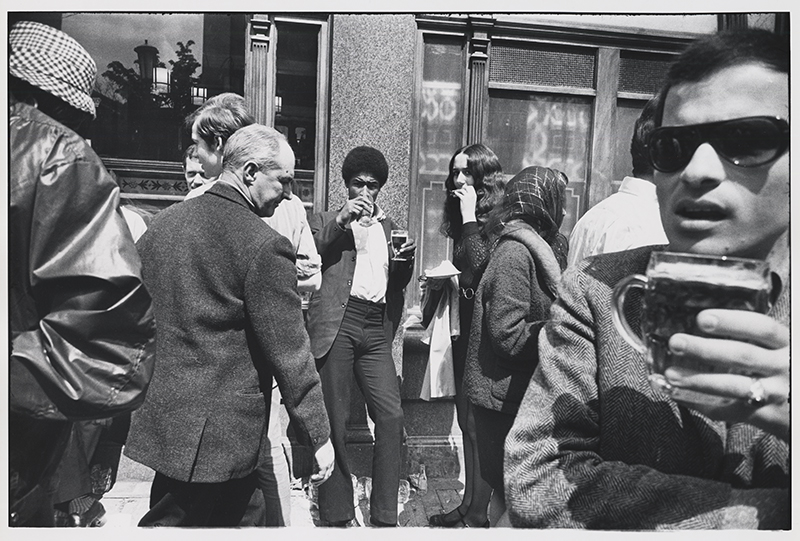 1969, London.
1969, London.
In The Lay of the Land, Richard Ford’s narrator, Frank Bascombe, wonders what future thinkers will make of our civilization. The first thing that comes to mind is that we “liked beer.” Like Winogrand, Ford is “a student of America” but students of Britain will want to insist that no one likes beer more than the British do. And we like it in a particular way. We like it in pubs, we like it in pint pots, and we like it served at room temperature. Jeez, writing this and looking at that big pint of bitter in the guy’s hand makes me want to reach into the picture and get one down me.
So yes, beer, even though it turns out that this is the only drink in shot that can be definitively identified as a beer (i.e., bitter). The black guy is holding his girlfriend’s drink while she rolls a roll-up. What are they drinking? Halves of lager or lager and lime? What’s it matter? I don’t know—but I’d still like to know. I’d like to look more closely but the photograph discourages this. The picture captures a particular look or way of looking: how people look—in the sense of look at you—while drinking. It’s a look that does not encourage close looking.
If one wanted to go all Barthesian, one would notice the tightness of the black guy’s trousers but this is not Paris, not a café terrace where intellectuals sip Beaujolais and talk about punctums. It’s an English boozer where people stand outside the boozer, boozing and spilling out onto the streets and creating a slight obstruction or passersby. But one of the nice things about outdoor boozing is that the distinction between pub and street dissolves completely and on warm days the whole city becomes a giant pub, so no one really minds—and, in any case, the impeded pedestrian is probably a drinker hurrying inside to get his round in.
“The picture captures a particular look or way of looking: how people look—in the sense of look at you—while drinking. It’s a look that does not encourage close looking.”
Yes, cheers. Same again, please. Anyway, where was I? Ah yes, apart from the beer, I also like the way that Winogrand captures the texture of England. Starting from the inanimate background and moving outwards we have glass, wood, and pebble dash. And then we have the clothing: from shiny anorak, to tweed, herringbone, cotton, furry collar—it’s all there in rough and boozy harmony.
Note also how the hat on the left seems to be floating on nothing, as if it’s being worn by the invisible man: the looker who cannot be looked at. Do not conclude, from this, that there is such a thing as the drink that cannot be drunk.
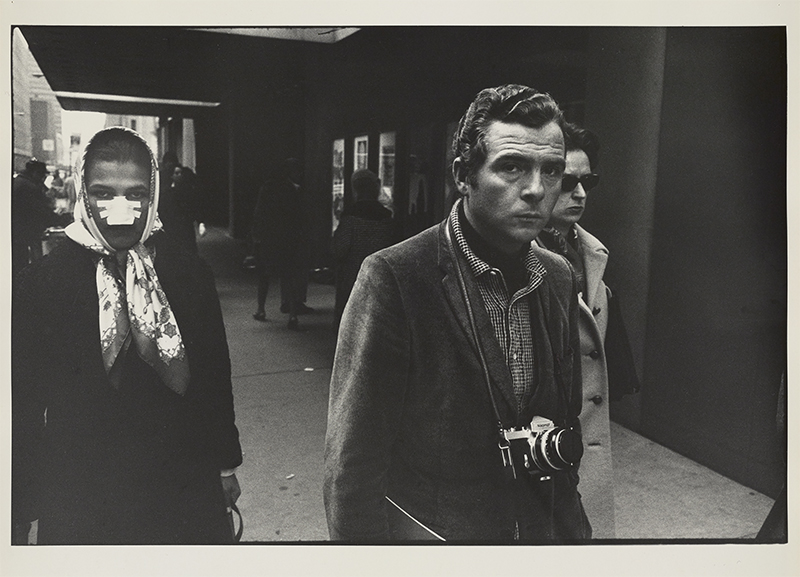 1968, New York.
1968, New York.
The question, obviously, is about relationships. Not simply, are these two people related (man and wife?) but what is the relationship between photography and personal injury? The answer to the second question depends somewhat on the answer to the first.
If they are together, then it seems a little odd that she is walking a pace or two behind her husband or partner. Some Muslims adopt this practice (my wife and I adopt it from time to time, squabbling over whether I am walking too fast or she is dawdling) and in some strange way the bandage over her nose serves as a notional or negative hijab, concentrating our eyes on what can’t be seen. Even if they are not together—not an item—they are united by the look of suspicion and hostility that they bestow on the photographer. This is fairly unusual in Winogrand. Typically, it’s just one person in the scene—an onlooker more often than the principal subject—who glares, disapproves. Since the man is a photographer, you might expect him to be understanding—they’re in the same line of work, after all—but perhaps he feels that the woman is his photographic property.
Maybe she’s had cosmetic surgery to render herself more beautiful to male eyes—to those of the two photographers who’ve played a part in the creation of this image—or to herself (though it becomes difficult to disassociate the latter from the former). But there is another possibility: that, in a more literal version of the fear that a photograph steals your soul, the act of being photographed has a corrosive effect; that taking someone’s picture is the passive equivalent of an acid attack. (Photographers use the darkroom technique of “burning” to make areas of a print darker.) Your photographing me has burned a hole in my face, she silently declares. You have damaged the thing you love looking at—by looking. There is, to go back to our framing question, an implied relationship between photography and physical harm. Both Winogrand and the other photographer are complicit in this.
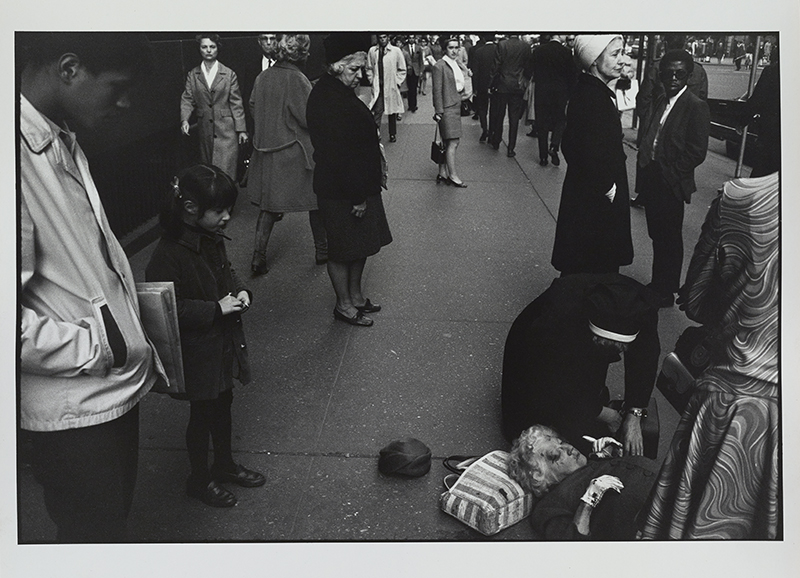 Ca. 1968, New York.
Ca. 1968, New York.
You could construct a novel—a whole sequence of novels—out of Winogrand’s pictures, using the same cast of characters. These characters are not individuals so much as highly individualized instances of character types. We have, for example, quite a few nuns, but let’s say, for the sake of continuity, that they are all incarnations of “the nun,” or “the old lady,” and so on.
We see the nun walking with her friends and the old lady with her friends. At some point—this one—nun and old lady meet. But that’s not all. The meeting is accompanied by a merging as the old lady becomes conflated with another type, “the injured lady,” whom we’ve previously observed hobbling along and who will eventually reappear swathed in a bandage dress so that she is in turn a reincarnation of one of “the beautiful young girls in dresses.” So the earlier comparison with Balzac and the social novel becomes inadequate in the face—or faces!—of what is going on here. We might even be in some documentary corner of the mythic as described by Roberto Calasso in The Marriage of Cadmus and Harmony: “Mythical figures live many lives, die many deaths, and in this they differ from the characters we find in novels, who can never go beyond the single gesture. But in each of these lives and deaths all the others are present, and we can hear their echo.”
“You could construct a novel—a whole sequence of novels—out of Winogrand’s pictures, using the same cast of characters.”
Turning back to this particular picture, look at how the bystanders are . . . standing.
It’s easy to think of Winogrand as somewhat haphazard, at odds with any kind of formalism—but if this were a scene from a film by Alain Resnais wouldn’t we feel that it had been almost too artfully composed, that it was too posed, like a still from a gritty remake of Last Year at Marienbad?
And note, finally, the old/injured lady’s white glove. This is the clinching bit of forensic visual evidence in the complex web of Winograndian recurrence. We’ve definitely encountered this glove before, back in the 1950s.
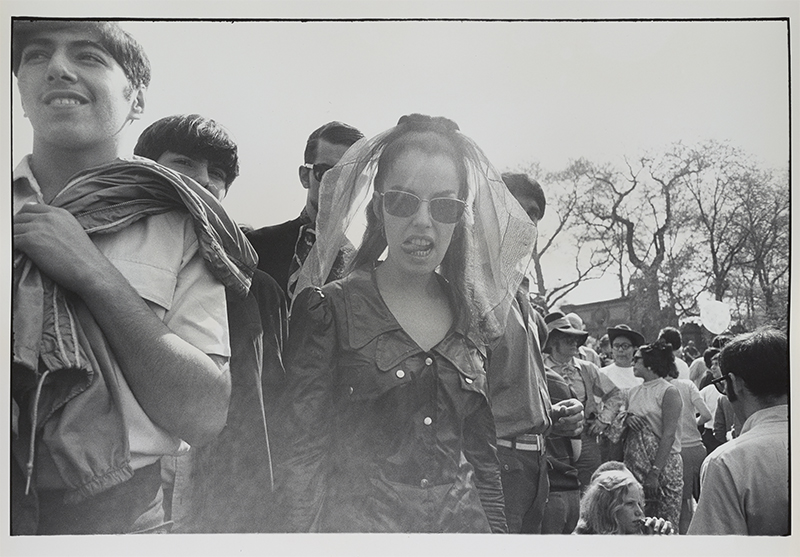 1969, Central Park, New York.
1969, Central Park, New York.
Like Dylan in “Tangled Up in Blue,” we’ve seen a lot of women in Winogrand’s photographs. More exactly, we’ve seen a lot of women who knew they were being looked at. We’ve seen a girl like the one described by Rebecca West in A Train of Powder “who knew she was being looked at by the world, and being proud and innocent, let it look.” We’ve seen a numbers of girls at the stage described by the narrator of Emma Cline’s novel about coming of age in the 1960s, The Girls, when she “was just starting to learn how to be looked at.” We’ve seen the woman in the phone booth who perhaps knew she was being looked at. . . . And finally here we see Winogrand getting his comeuppance, confronted with a frank expression of sexual power and freedom, of contemptuously lascivious independence. And yet the balance between naked display and discretion manages to reassert itself. Her inner life and taste—the tongue!—are fully revealed but also subtly and doubly withheld, by veil and shades.
If the net veil harks back to the barely disguised outlaw, Bonnie Parker, everything else suggests the street camouflage of the urban guerrilla, a Patty Hearst figure who doesn’t need to be kidnapped in order to fully absorb the revolutionary imperatives of the age. But those demands, it turns out, might be best expressed not by the demented and deluded communiqués of the Symbionese Liberation Army—“Death to the fascist insect that preys on the body of the people!”—but by the pout and leer of Mick Jagger’s lips, “the corporate logo of the Western world,” according to Klara, in Don DeLillo’s Underworld. It’s after a screening of Cocksucker Blues, Robert Frank’s film of the Stones’ 1972 tour of America, that Klara comes to an understanding of what it is about that tongue that so haunts her. “I think everything that everybody’s eaten in the last ten years has gone into that mouth,” she says. But no, it’s not only that. “You have to interpret the mouth like it’s satire,” her companion explains. And there you have it: this expression of barely concealed carnal appetite is also satirizing Winogrand and his ilk, these men prowling around with their little cameras; she’s giving them what they want while also deriding their entire undertaking.
And if you find her contempt arousing, well, there’s plenty more where that came from. There’s nothing tongue-in-cheek about it.
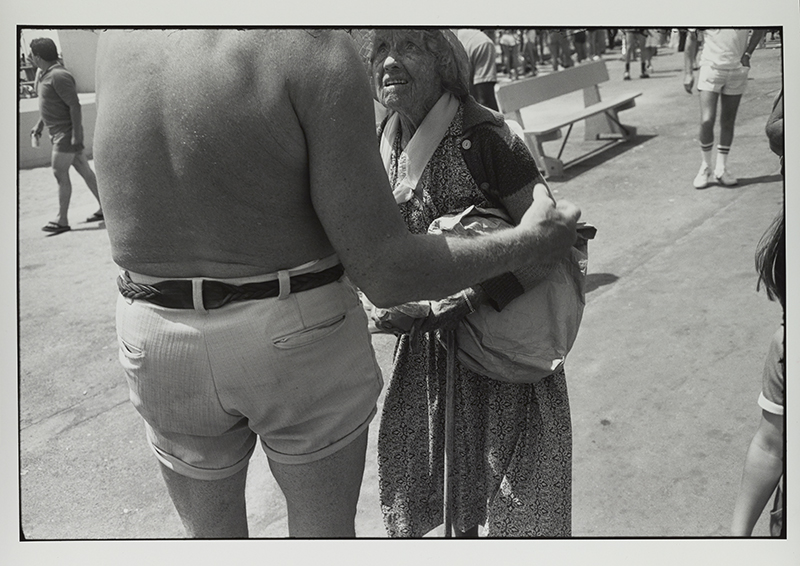 Undated, Los Angeles.
Undated, Los Angeles.
If you spend enough time on the streets you will come across everything. Not just all the different permutations and combinations of the real; every moment from parables, myths, and fairy stories will be enacted before your eyes. But they will not unfold over and in time, as they do in books; they will manifest themselves in the blink of an eye and it will not be clear, in that blink, exactly which story or narrative this particular glimpse is part of. Take this one. What on earth is going on here? In order to answer properly we need to see what the old woman is seeing but there are clues in her face, in its mix of terror, trust, and absolute vulnerability. And this gigantic man—from what depths of the unconscious has he emerged?—how much bigger than her can he really be? He is made to appear bigger by the smallness of his shorts, which seem as short as the ceiling looks low in Arbus’ famous picture of Eddie Carmel, a Jewish giant at his home in the Bronx. Arbus catches Eddie’s parents looking up at him with a mixture of horror and love.
“The bulk of the answer has its back to us and the rest is beyond the edge of the frame.”
I see this as Winogrand’s retake or updating of Arbus’ image as he catches up with or stumbles upon two of the participants from that picture, that tale: mum and son, both of them much older but still stuck in the same abject ratio of love and size. She can’t believe it’s her son whom she loves so much, even if that love is tinged with horror and fear. Maybe her marbles are starting to roll; she’s having trouble recognising him. Her bag is a jumble of memories through which she has no time to rummage. He is very patient but there is something awful about this meeting as he reaches for her bag and seeks to reassure her that he is who he claims to be.
At the same time, you share her uncertainty as to whether he is indeed her son or a random stranger looming with threat, even if the threat is intended kindly. It’s like a turned-around version of the moment when Lear encounters a woman he takes “to be my child Cordelia.” Is this her child? The bulk of the answer has its back to us and the rest is beyond the edge of the frame.
![]()
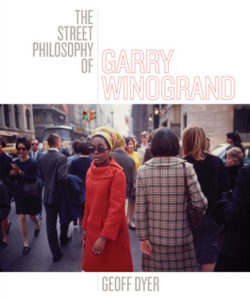
From The Street Philosophy of Garry Winogrand. Used with permission of University of Texas Press. Text copyright © 2018 by Geoff Dyer. Photographs copyright © 2018 by the Estate of Garry Winogrand.


